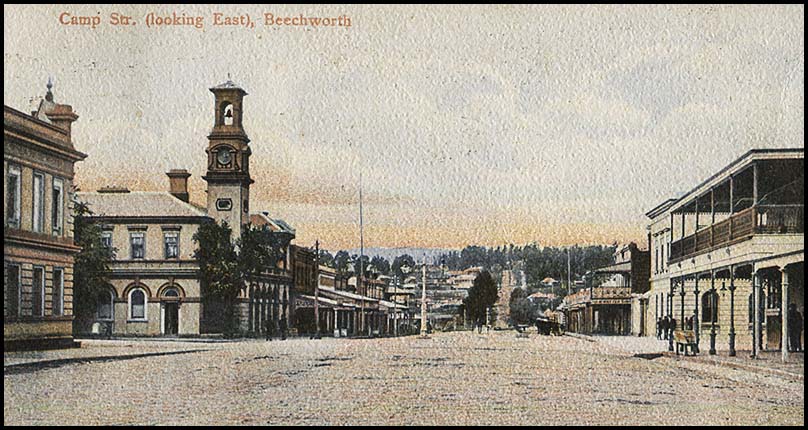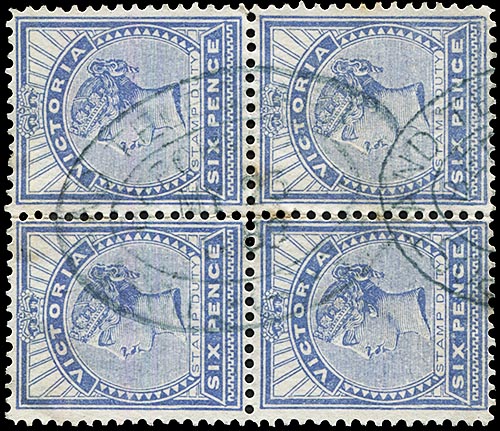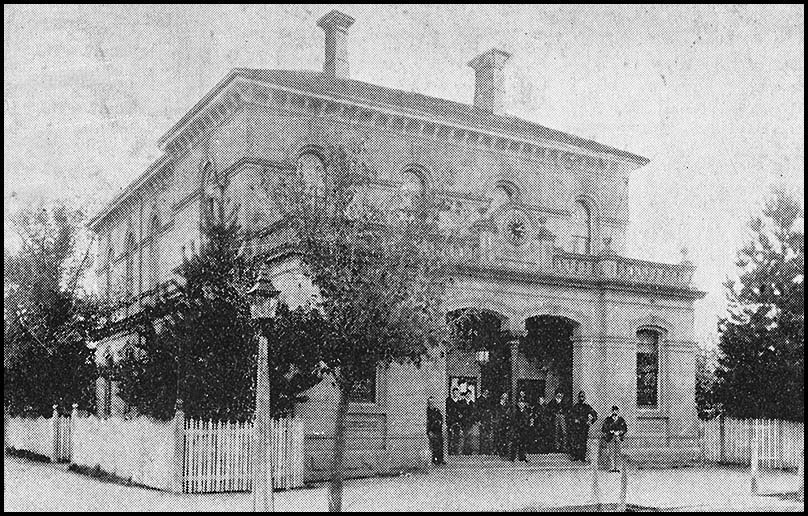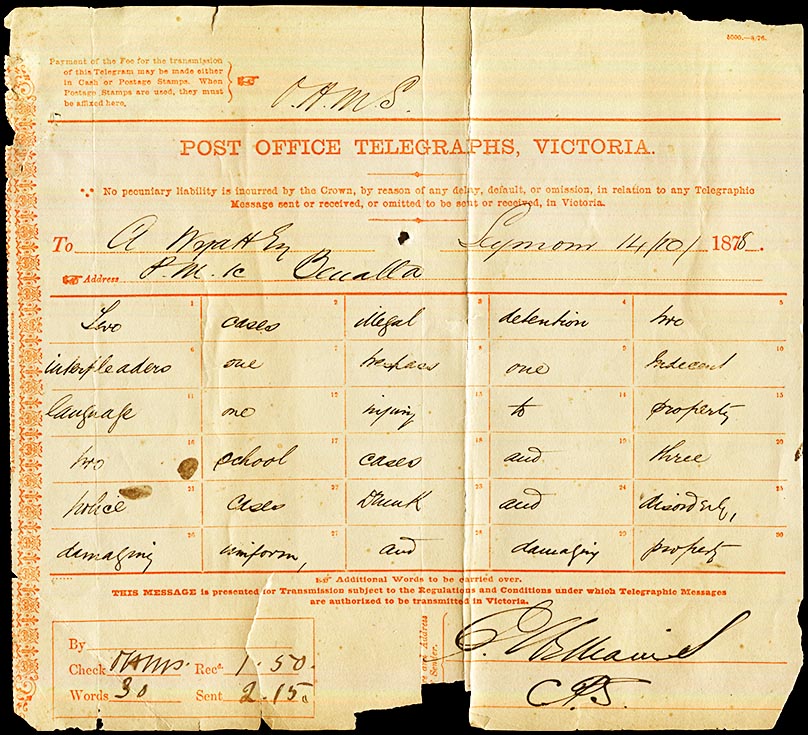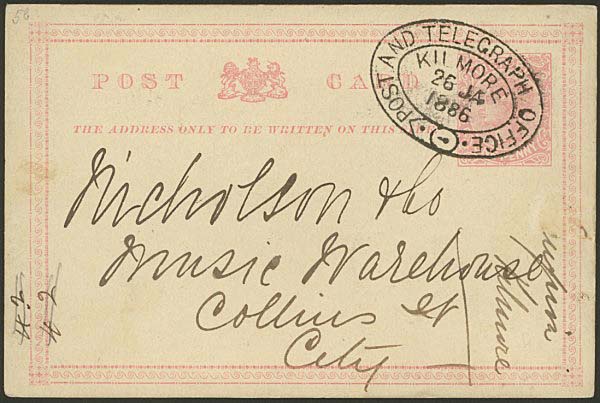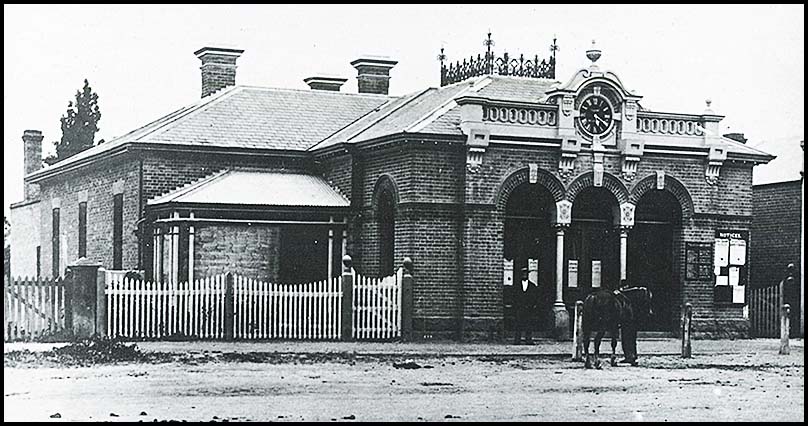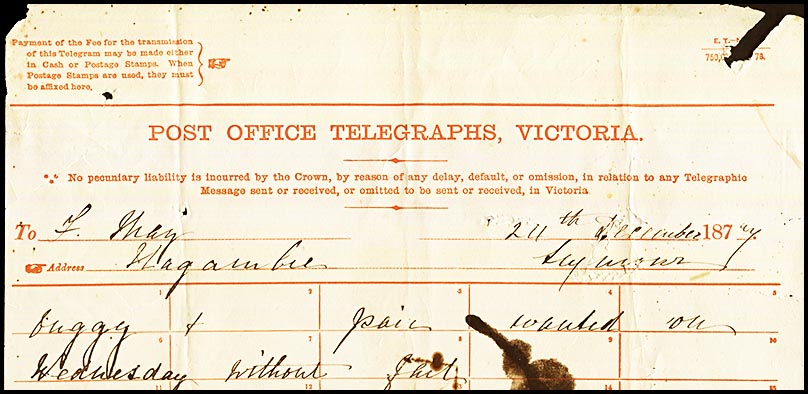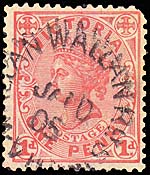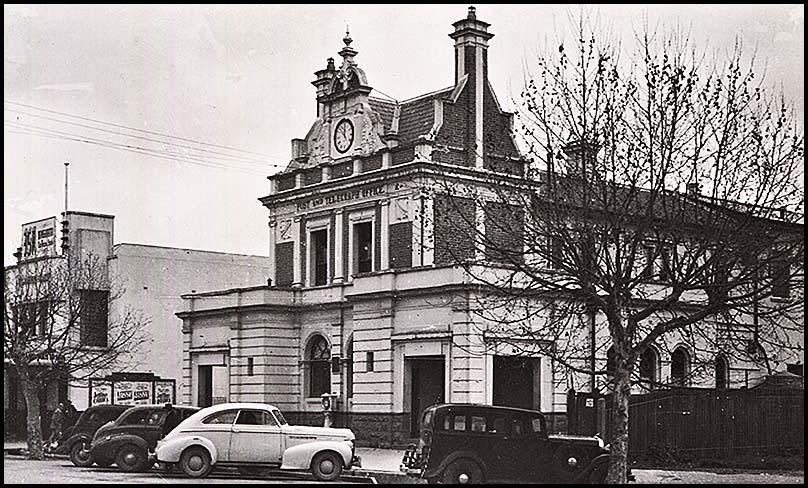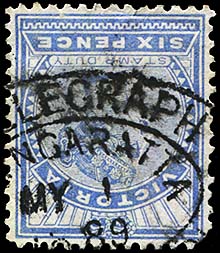Telegraph Offices on the first line to New South Wales - the Albury (No. 1 and No. 2) lines.
- Australia 1901-1988
- New South Wales
- Overview of NSW
- Telegraph lines
- Telegraph Offices
- Date stamps
- Forms
- Envelopes
- Instructional annotation
- Collect
- Delayed
- Free
- Immediate Urgent
- Reply paid
- Rates
- Stamps
- 1871 Telegraph stamps
- 1885 proposal
- 1893 proposal
- Queensland
- South Australia
- Tasmania
- Victoria
- Western Australia
- International
- Special aspects
There were three Branch lines associated with the main line constructed to Albury and Wodonga. The following table lists alphabetically all stations on the main line and on the branches. The hyperlinks lead to the appropriate webpage with the information for the required Office.
| Avenel | Beechworth | Benalla | Broadford | Chiltern | Euroa |
| Heathcote | Homeward | Kilmore | Longwoood | Puckapunyal | Reedy Creek |
| Seymour | Tallangatta | Wallan | Wangaratta | Wodonga | Yea |
|
The Telegraph Office opened in November 1874 although a Railway Telegraph Office had opened in December 1872 - soon after the railway station had opened on 29 November. The Post Office had opened on 2 June 1858. Avenel was also on the Wood's Point line. Avenel is where Ned Kelly was born and went to school. His brother and father are buried in the Avenel cemetery. |
| Beechworth.
On the 23rd of August, 1856, Beechworth was by the proclamation of His Excellency, the Governor of the colony, created a municipality under the control of a Council of seven. It embraces an area of 1562 acres, including that portion of the Ovens gold field known as Spring Creek ... between that date and December 1860, amounts to no less than 1,282,451 ounces and 5 dwts. of gold have been processed through Beechworth" (see further details in the Ovens and Murray Advertiser of 28 September 1861). Tenders for a Telegraph Station at Beechworth closed on 3 November 1857. In the Legislative Assembly on 6 January 1858, "Mr Aspinall asked the Treasurer whether the Government intended to rent some place as a temporary Telegraph Office at Beechworth, as was done at Longwood, pending the erection of the permanent office - Beechworth at present deriving no benefit though the telegraph is completed to Albury. Mr Ebden said that rooms had been rented for the purpose alluded to and the office would probably be opened on Tuesday next (12 January). Tenders had been already accepted for the erection of a permanent Telegraph Office". |
||
|
||
The temporary Telegraph Office was opened on 12 (?) January 1858. The Ovens and Murray Advertiser of 21 January 1858 reported:
The opening date for the permanent office is unclear. Alterations and repairs were however made in 1873. Mr. Horrice Burkitt was gazetted as the Manager of the Beechworth Telegraph Office in lieu of J. J. Austin as from 1 January 1861. William Penn Hamilton was gazetted in October 1861 as Acting Manager of the Telegraph Office at Beechworth from 20th of August to 10th of September in lieu of Horace Burkitt who was absent on leave - but Horace returned on 11 September 1861. The Ovens and Murray Advertiser noted on 16 March 1871 that "Captain Bance, the inspector of Post and Telegraph offices, arrived in Beechworth yesterday in the course of an official tour. His duties will be lighter than they were when the two offices were in separate buildings and he will no doubt see the great advantages which have resulted from combining them in the present handsome building". The Ovens and Murray Advertiser reported a special incident on 23 January 1879:
As an aside, the Ovens and Murray Advertiser of 26 March 1878 reported the trial of an amazing new technology:
A non-telegraph aside about Beechworth which is included because no-one could make it up!!
|
||
The Post & Telegraph Office was issued with a 1 hole Belt & Buckle date stamp.
|
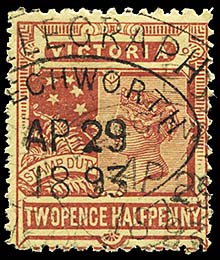 29 April 1893. |
|
A very faint impression. |
||
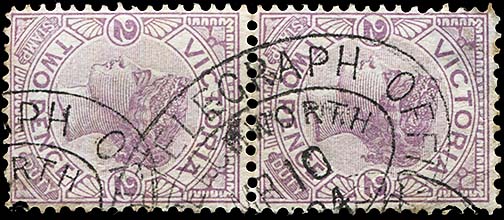 10 March 1894. |
||
In February 1862, a severe storm hit the area. Part of the report on damage noted:
An excellent description of the gas being connected at Beechworth in 1882 to light the Post and Telegraph Office can be accessed elsewhere. |
||
| Benalla.
The Telegraph Office in Benalla opened May 1858. The tender for the erection of the Telegraph Office at Benalla was let in December 1857 to A. Amos & Co. for £1,005. On 29 January 1881, the Commissioner of Public Works met with a number of Benalla gentlemen at Craven's Hotel. They raised with him the long-promised new Post and Telegraph Office buildings for Benalla. The Commissioner informed the delegation that "the local Shire Council could deal with that matter". |
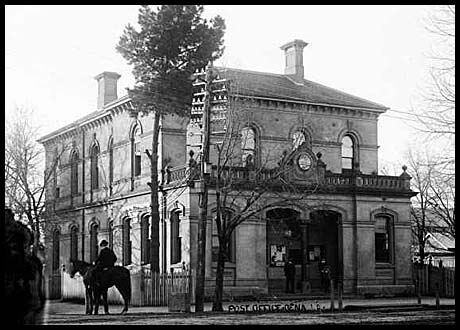 Benalla Post & Telegraph Office - a later view that that below - there is now a telegraph post (and a horse) outside. |
|
|
||
Personnel: 21 April 1863: "Albion Charles Croft to be Manager of Electric Telegraph and Collector of Imposts, also to act as Postmaster at Benalla from 1st April, 1863 vice Krone". There was also another person of note at Benalla: Sly Grog at Benalla.
A Rail Telegraph Circuit was connected and an office opened at the Benalla Railway Station on 22 August 1873. |
||
Early usage. A message transmitted to Benalla from Seymour on 14 October 1878 and recorded on a transmission form (VC-TO-7A) is the earliest recorded form involving the Benalla Telegraph Office. It outlines the cases to be heard at the local District Court in Benalla. The form is also marked OHMS because it was transmitted on Government business.
|
||
Date stamps. The Telegraph Office was issued with five formats of date stamps for use with the telegraphs. |
||
|
||
|
||
|
|
|
|
||
|
||
| The usual postal date stamps were also used on telegram forms. |  16 February 1906. |
|
The Benalla Railway Station was issued with a double circle Used in violet: 14 December 1972 (only recorded date). Size: not known complete. Rated: RRRR. |
||
|
On 28 July 1870, the Chairman of the Broadford Board convened a meeting for Tuesday 2 July "to discuss the advisability of asking for a telegraph office at Broadford". Telegraphic communication was opened to Broadford on 2 May 1872. Not all was rosy in Broadford - even after the telegraph brought so much joy to the inhabitants. The Perth Inquirer of 27 March 1896 reported the decision by the local Rev. Raymond to ban dancing as being "not for for Christians' ears". |
| Euroa.
The Telegraph Office opened in August 1876. On 10 December 1878, the Kelly Gang raided the Euroa National Bank and robbed it of £418 in £1 notes, £335 in £5, £680 in £10 notes, £100 in mixed notes, £311 in gold, £98 in silver, 31 oz of smelted gold, two revolvers, five bags of cartridges and one silver watch. On the night after the robbery, the Gang escaped to Ghin Ghin - three miles from Yea. Fuller accounts of the robbery are provided in https://tomelbourne.com.au/the-kelly-gangs-euroa-national-bank-robbery-of-1878/ and in one of the Press Reports in The Argus of 13 September 1878. Even better is the following personal account given to me by Mr. John Watts: "My Great Grandfather John Wesely Watts emigrated to Victoria from England in 1874 and became a Telegraph Line Repairer - eventually becoming Head Lines Foreman about 1907 before he retired. As part of their preparations to rob the Euroa Bank, the Kelly gang cut the Telegraph wires and bailed up everyone into the Faithfull's Creek Station’s storeroom. John Wesley Watts was dispatched from Benalla to find the 'fault' and affect repairs. He caught a train from Violet Town and about 5pm he alighted from the train, making his way to Faithfull’s Creek Station. He was made captive by Joe Byrne, one of the Kelly Gang who was left on guard, and placed with the other hostages". As with any bureaucracy, J. W. Watts was asked "to write out a report for the Department of what happened. A copy of his report was revived and got into the newspapers after he died in 1917". |
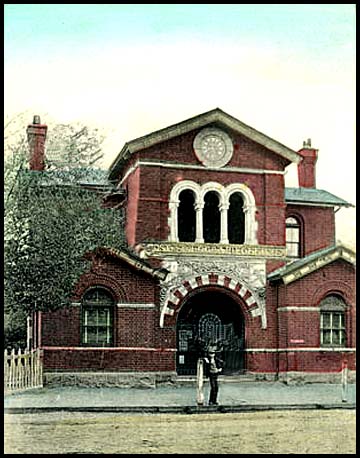 Euroa Post & Telegraph Office. |
In the Gazette of 6 December 1883, Mr. J. H. Brewer was announced as the successful tenderer for the construction of a new Post and Telegraph Office at Euroa at the tendered price of £1,665. The Telegraph Office was burnt down in 1889 and moved into temporary accommodation pending the erection of another building. Euroa was also on the Wood's Point line. |
|
Euroa was issued with a 1 hole Belt & Buckle date stamp:
|
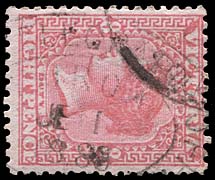 1 June 1888 (earliest recorded date). |
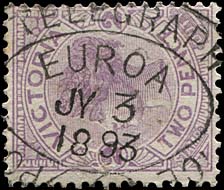 3 July 1893 (latest recorded date). |
| An example of a scarce complete strike for the Euroa Belt and Buckle. On a Shire of Euroa 1d apple-green PTPO envelope - a very scarce issue. Prestige Philately December 2012 Lot 825. |
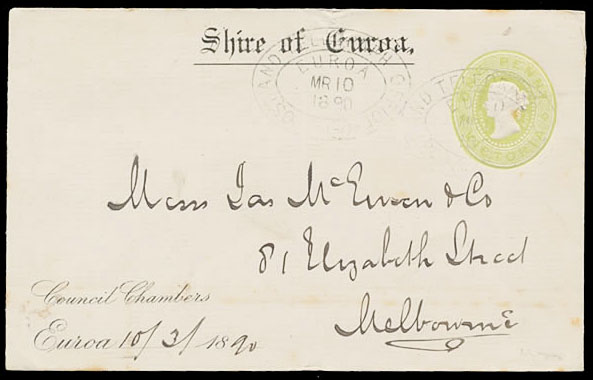 10 March 1890. |
|
|
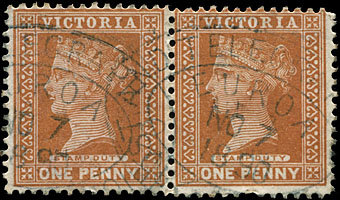 7 November 1890. |
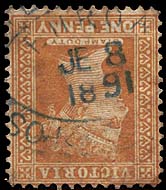 8 June 1891. |
|
The Post Office was originally established when Doogalook was renamed Homewood on 8 October 1894. The Office closed on 10 October 1975. |
|
It appears that the Office was issued with a T.O. date stamp. Used: 20 April???. |
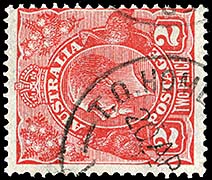 20 April ?? |
| Kilmore.
The Telegraph connection was made in October 1857. The Kilmore Examiner of November 1856 reported: |
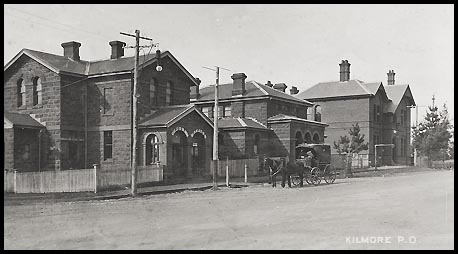 Kilmore Post Office. |
|
On 14 February 1860, Mr O'Shanassy asked the Hon. Treasurer "What are the intentions of the Government with respect to the erection of a Post Office at Kilmore?". Mr McCulloch replied in the affirmative but that the Post Office would be in connection with the Telegraph. Meanwhile, on the same day, Mr Bailey noted in the House that
In October 1861, the Gazette announced a tender for £2293 from W. Hetherington had been accepted to construct a Post Office and Telegraph Station at Kilmore. The Age of 18 June 1862 made the following strongly worded statement:
In May 1874, there was a case of a kidnapping at the Station - which ended well thankfully due to the quick thinking of the child's mother. On 29 November 1883, the Kilmore Free Press recorded that "The telegraph posts about here are being renewed and Mr. Hunt has made application to have some more sightly posts erected in the main street instead of the saplings the department is now providing". In April 1885, "Miss Nelson, for some time engaged as assistant in our local post-office, left here on Monday to take charge of the post and telegraph office at Wandiligong. Miss Nelson, who is a native of this place, was always distinguished for her courtesy and obliging habits in her contact with the public who, whilst regretting her departure, are nevertheless pleased at her promotion to a more important position. Miss Nelson was made the recipient of a handsome album by her fellow employees as a token of the esteem in which they held her". |
||
A Belt & Buckle date stamp was issued to the Telegraph Office.
|
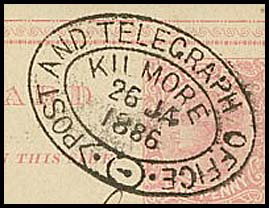 26 January 1886. |
|
|
||
| In addition, the usual postal steel date stamp - a Barred Numeral 54 - was also used on telegrams. | 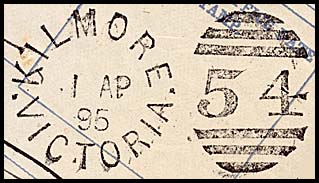 1 April 1895. On telegram of type VC-DO-15B. |
|
A report in the Geelong Advertiser of 22 May 1862 would have at least raised eyebrows if not a torrid of questions:
|
||
|
A rectangular TELEGRAPH date stamp (RRH1-T) was issued to the office at the Military Camp:
|
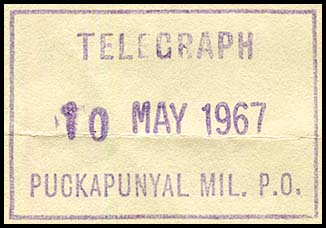 10 May 1967. Used on AA-DO-13D. |
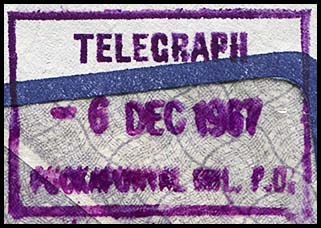 6 December 1967. Used on AA-EO-18. |
| Seymour.
The Telegraph Office was opened in June 1865. Seymour was a linkage office being also on other lines including the Wood's Point line. |
||
|
||
Constructing the Telegraph Office. In January 1874, a tender was accepted from J. Fitzgerald to erect a new Post and Telegraph Office at Seymour for £1,480. Soon after work had commenced, the Seymour Express of 5 May 1874 reported a case of kidnapping:
Operation of the Telegraph Office. There was frequently difficulties with the hours of operation of a Telegraph Office. One such incident happened at Seymour in April 1870:
On 18 May 1870, Mr. Duffy gave notice, in the Legislative Assembly, of a question: "Whether the Government have taken into consideration a memorial asking for better police protection between Broadford and Yea". |
||
Personnel: "In June 1884, Harry J. Howson, formerly Postmaster at Seymour and latterly Telegraph Operator at Melbourne was exonerated from the charges of irregularity upon which he was discharged from the service and he has therefore been reinstated". |
||
Early usage: The earliest evidence of the operation of the Seymour Telegraph Office is a transmission form (VC-TO-7B) used for a telegram sent from Seymour to Nagambie on 24 December 1877. |
||
Date stamps: Three formats of date stamp were issued to the Office for use with telegraphic matters: |
||
|
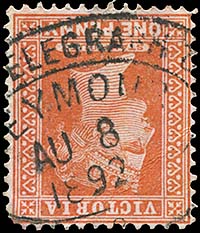 8 August 1892. |
|
|
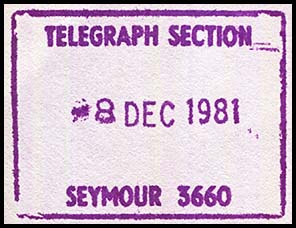 8 December 1981. |
|
|
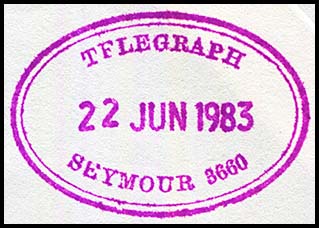 22 June 1983. |
|
Seymour Railway Station. A special steel date stamp was also issued to the Telegraph Office at the Seymour Railway Station. It was a double ring circular format (SC2-T).
|
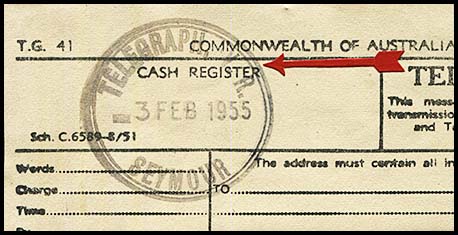 3 February 1955. |
|
| Wallan Wallan Railway Station.
The Post Office in the town (2 kms from the Station) opened on 1 April. The railway line was opened on 22 April 1872 and a Telegraph Office was opened at the Railway Station in May 1872. Postal facilities were added 1 October 1873. The Office was later renamed Wallan Wallan East and it was closed in 1992. Two date stamp formats were used:
|
Premier Postal Auctions January 2014 Lot 2640 plus the information about the date stamps. |
| Wangaratta.
The Telegraph Office was opened in July 1858. The tender for the erection of the Telegraph Office at Wangaratta was let in December 1857 to A. Amos & Co. for £1,025. William Shields was gazetted as the Manager of the Telegraph Office and Postmaster at Wangaratta from 12th August, 1861 in lieu of Arthur Poyntz who had been dismissed (see reference elsewhere). A tender for a new Post and Telegraph Office building was let to L. Griffiths for £2,219 19s in May 1873. New premises were occupied in early 1874. By 1884, there was a measure of discontent especially based on perceived bias in the treatment of offices on the Murray River (Shepparton, Yarrawonga and even Benalla, etc) compared to those of the Ovens ( e.g. Wangaratta). "We have to go no further than the two neighbouring towns of Benalla and Wangaratta to observe this pernicious system in full force. Benalla is crowded with new public buildings, which are kept in the neatest state of repairs while in Wangaratta, it has to be pointed out a dozen times that the fences round the public offices would be a disgrace to any private person who could afford to repair them, the Post Office has been left unpainted for eight or ten years, inside and out, the smoke from its office fire-places meet people in the face through the telegraph window instead of ascending the chimney, and as to the Post Office tower, promised by a former Minister, the Wangaratta people might as well ask for the keys of the gates of Paradise". The importance of the Wangaratta Show increased each year so that, for the 1884 Show, a Telegraph Office was set up in the Secretary's Department. Messages could then be sent from or received at the Showground during the two days without having to go into the town for transmission. |
||
|
||
A story of its time: THE KELLYS.
Ovens and Murray Advertiser, 24 January 1880. |
||
The office was one of the first to be issued with a Belt & Buckle date stamp. The date stamp had one hole but it has not been recorded complete.
|
|
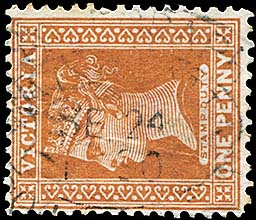 24 September 1890. The NG of WANGARATTA is seen below the EL of TELEGRAPH and the TT is below the PH. |
|
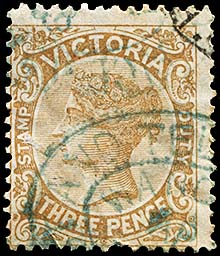 Ap(ril). |
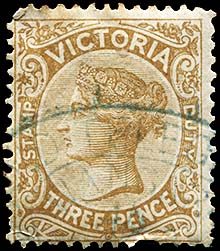 Date unclear. |
A Telegraph Office was also opened at the Wangaratta Railway Station at some time. This Office was also issued with a rare format of a date stamp (RO3-SMO) which was used with telegraphic activities.
|
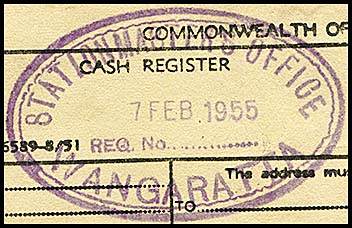 7 February 1955. Used on AW-TO-10Ca. |
|
Postal date stamps were also used for telegraphic activities. Unframed date stamp.
|
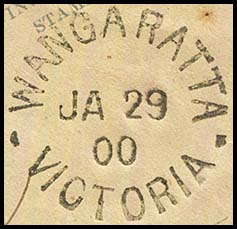 29 January 1900. Used on form VC-DO-16B. |
|
SC1-W framed date stamp.
|
|
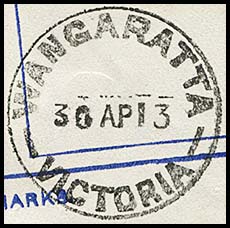 30 April 1913. Used on VI-DO-3Db. |
| Wodonga (Belvoir).
In November 1857, the Government advertised tenders for the construction of 10 Telegraph Offices in conjunction with the first telegraph lines to South Australia and to New South Wales. Belvoir was one of those Offices. The Telegraph Office opened in January 1858. Originally named Wodonga, its name was changed to Belvoir then later back to Wodonga. The Post Office opened 1 June 1856 although known as Belvoir until 26 July 1869. In 1858, a small boy, 13 years of age, was employed as a messenger in the telegraph office at Wodonga in Victoria. He received as a remuneration thirty shillings per week and sixpence per mile for all messages conveyed by his hands. His earnings amounted to about £3 weekly. Across in NSW, the Albury Postmaster, who filled a responsible office and was burdened with the performance of heavy duties, received the paltry pittance of £1 18s. 6d. weekly. Mr Anthony Cheyne had the position of Post and Telegraph Master for 12 years but was transferred to Wangaratta in January 1882. Mr Joseph Arundel replaced him on 18 January 1882. |
||
The Office was issued with three date stamps for use with telegraphs:
|
 10 October 1892. On a 6d blue Stamp Duty. |
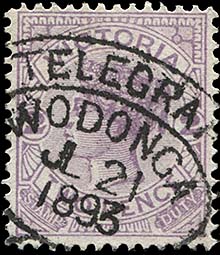 21 July 1893. |
|
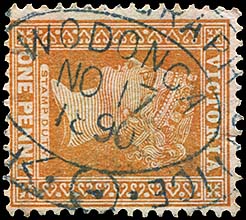 17 November 1890. (earliest recorded date). Provenance: Elsmore, Johnstone. |
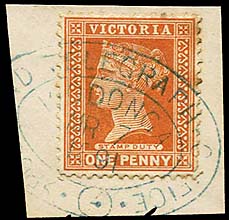 7 March 1891. |
|
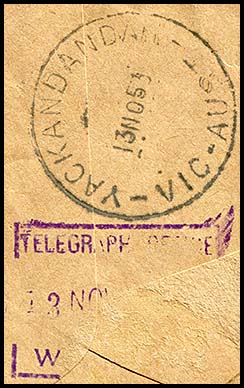 13 November 1951. Partial strike on flap of OHMS envelope sent from Yakandandah to Kergunyah. |
|
3. a horizontal rectangular (RRH1 - TO)
|
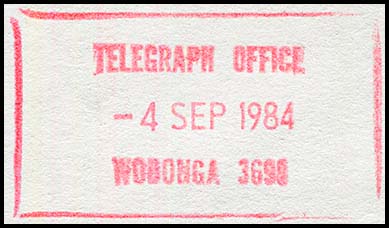 4 September 1984. |
|
|
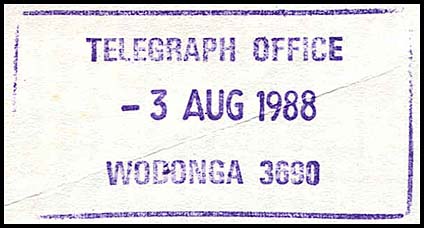 3 August 1988. |
|
| A circular rubber date stamp was also used at the Telegraph Office located at the Railway Station. That Office was opened in about 1910 and closed on 1 July 1977. |
|
|
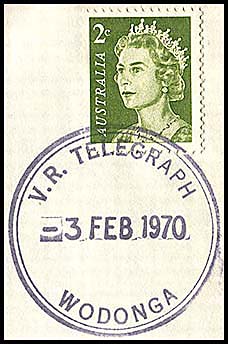 3 February 1970 - earliest recorded date. Used on piece. |
